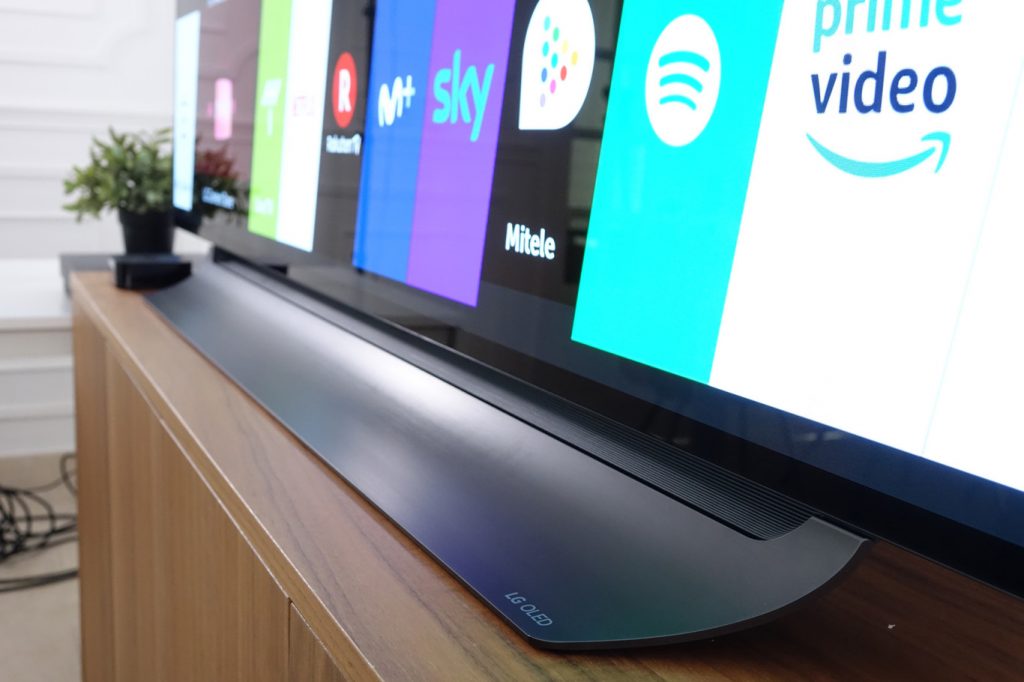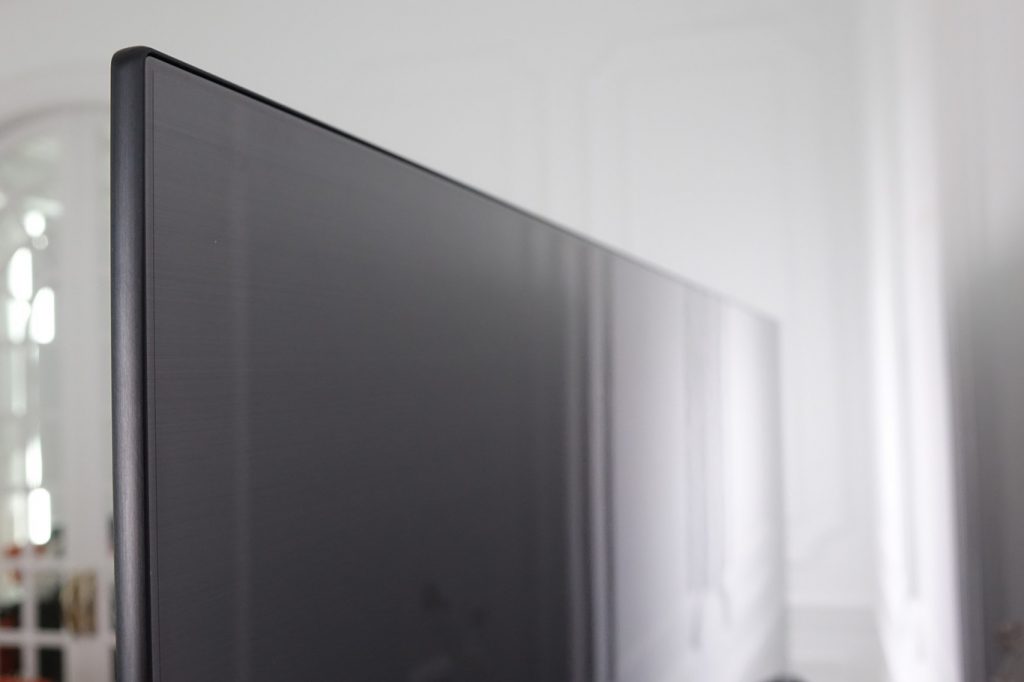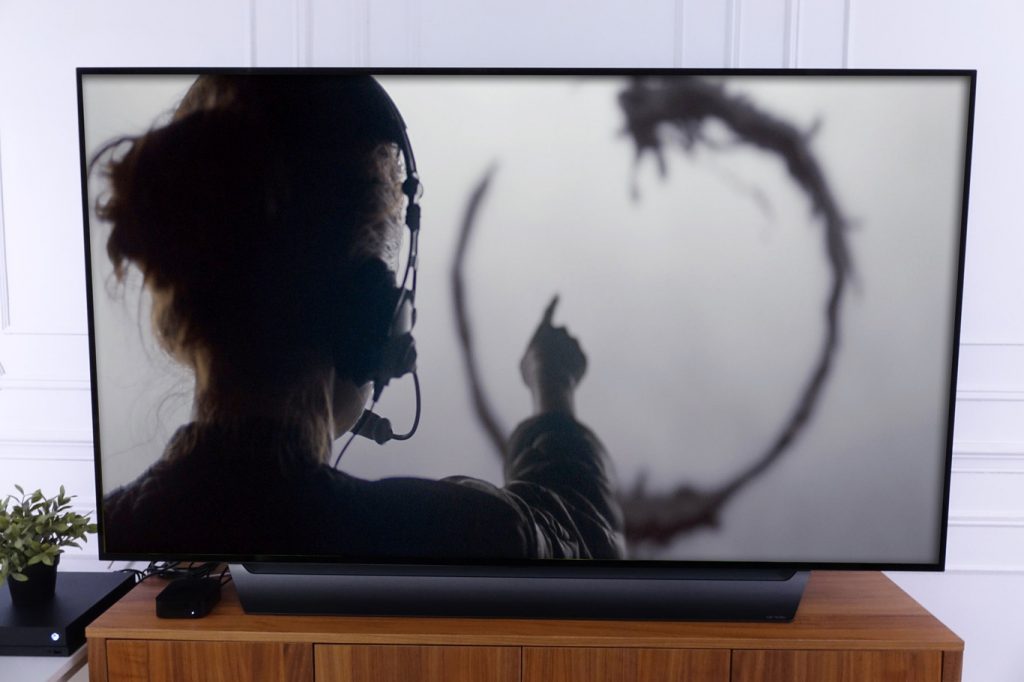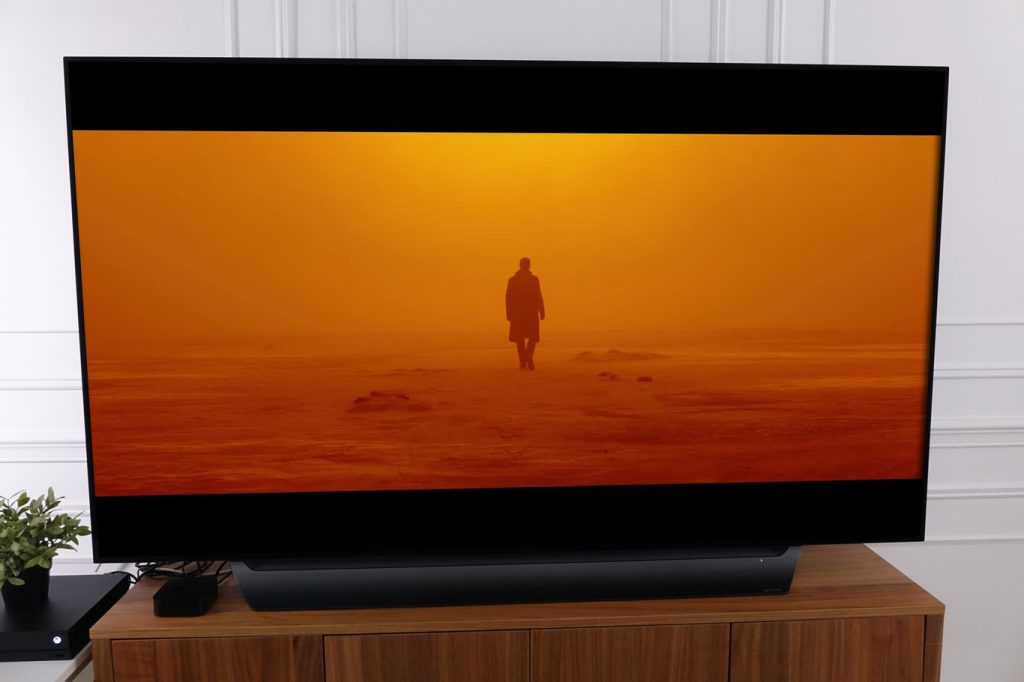At the end of last year we had the opportunity to analyze one of the OLED TVs that we most wanted to put “eyes on”: the 55-inch version of the LG C7 family. The reason why we were initially struck by this television was not the possibility of accessing the image quality of an OLED panel model for a price that, without being a bargain at all, was reasonable and more competitive than habitual. After our tests our initial expectations were confirmed: the models of the C7 range had a great price / performance ratio.
With this precedent it is understandable that we have not missed the opportunity to analyze in depth one of the models of the C8 family, which, as you can guess, is the successor of the C7 range in the LG portfolio for 2018. Of course, this time the model that has made us LG is the 77-inch, identical to those of 55 and 65 inches, but with significantly larger dimensions, as expected due to the increase in the diagonal of your panel. The challenge that faces this TV is to show us if the C8 family has a cost / performance ratio as attractive as the C7 range we tested last year. We suggest you continue reading and find out together.
LG OLED C8: Technical specifications
Unlike the B8 series, which is LG’s family of entry to the OLED range this year, the C8 has the same image processor as the superior E8 and W8: the Alpha 9 chip. This processor is a design with four processing cores (CPU), four other graphics processing units (GPU) and its own DDR memory. Unlike Alpha 7, which was the most advanced image processor that LG had last year, the Alpha 9 is capable of processing data of up to 14 bits, which undoubtedly positions it as one of the most interesting components of the new televisions of this brand.
The other novelty that the South Korean brand has introduced in its televisions this year is the ThinQ technology, which represents the arrival of what LG calls “real artificial intelligence”. On paper their possibilities are similar to those offered by the smartphones of the brand that also have this innovation, but, apart from its obvious use as a marketing tool, which is something that we as users at this time do not it impresses us, what matters to us is its possible impact on our experience. We will delve into this area a little later.
| TECHNICAL SPECIFICATIONS | LG OLED C8 |
| Available sizes | 55, 65 and 77 inches |
| Panel | 10-bit OLED |
| Resolution | 4K UHD (3,840 x 2,160 points) |
| Image processor | Alpha 9 14 bits |
| HDR | Dolby Vision, Technicolor, HDR 10 and HLG |
| DCI P3 color space coverage | 99% |
| Color mapping | LUT 33 x 33 x 33 |
| Physical connections | 4 x HDMI, 3 x USB, 1 x EIAJ / TosLink optical output, 1 x coaxial antenna input (DVB-T2 tuner), 1 x RJ-45 and 1 x minijack headphone output |
| Wireless connectivity | WiFi 802.11ac and Bluetooth |
| VESA compatibility | Yes (300 x 200) |
| OS | WebOS 4.0 |
| Sound | 2.2 channels with 40 watt woofer / Dolby Atmos |
| Dimensions with base | 1.228 x 757 x 230 mm (55 “) / 1449 x 881 x 230 mm (65”) / 1,722 x 1,052 x 253 mm (77 “) |
| Weight (Kg) | 19.1 (55 “) / 25.4 (65”) / 36.5 (77 “) |
| Price | 2,130.81 dollars (model of 55″) |
One of the most attractive features of this TV is, without a doubt, its compatibility with most of the HDR formats that are slowly being made with the support of content producers, such as Dolby Vision, a technology of which we have talked to you quite thoroughly in other articles, advanced HDR of Technicolor, HDR10 Pro and HLG Pro. The native contrast and the range of color that are capable of reproducing OLED TVs are two characteristics that, together with the maximum level of brightness that they manage to deliver, contribute to make the HDR look great on the models that use this panel technology.
Another interesting feature of this LG TV, especially if we keep in mind that it is usually the “Achilles heel” of most of the TVs that have reached the market in recent years, is the sound. This model, like other proposals of this brand, is capable of processing Dolby Atmos sound, which, instead of working with channels, does so with objects that can be positioned in a three-dimensional space around the spectators. A little further on we will discover if the sound of this television is satisfactory or if, once again, the best option for fans of home cinema and video games is to resort to an external audio equipment.
Design and finishing of first division
In the first lines of the text of this analysis I confessed that the model of the C8 family we have had occasion to analyze is the 77-inch, a “monster” with a scale that intimidates (measures 1,722 x 1,052 x 253 mm with the pedestal included). However, in spite of its size, it is an elegant and uncouth TV thanks, above all, to the fineness of its frames (0.9 cm) and the careful design of its base, made entirely of aluminum and with an impeccable machining. If these are the sensations that this model transmits, we can trust that the other two televisions of this family, the models of 55 and 65 inches, are at least equally attractive from an aesthetic point of view.
In the photographs that illustrate the analysis you can see that the base does not match the width of the television, but it has an important length. This design I like even more than the base of the E8 family because it guarantees excellent stability even in a model as bulky as the 77-inch. This is a characteristic that usually goes unnoticed, and it is a shame that this is so because a well-designed base and able to provide the TV with a high stability can avoid an upset, especially if there are children at home and we run the risk that the TV suffer a fortuitous blow that could cause its fall.
In the photograph that you have below these lines you can see the finish of the side profile of the panel, machined in aluminum and with a really nice design. The upper half of the television is completely flat and has a minimum thickness because the electronics reside in a block housed in the lower half. Even watching it from behind, this TV is quite attractive.
Continue Reading: Thinking of buying an OLED TV? These are some of the best proposals we have seen so far this year
The experience that offers us in our day to day
In the next two sections we will delve into the image quality that this television offers us and the experience it offers us when we use it to enjoy cinematographic contents and videogames. However, before arriving at that part of the analysis, it seems interesting that we investigate other characteristics of this model that also have a direct impact on our experience, and that do not always receive the attention they deserve.
One of them is the design of the menus in which we are forced to submerge when we need to access the configuration parameters of the TV, or we have to install or run an app, among other options. As you can see in the following picture, the menus of this TV are not very different from those of other LG models with WebOS that we had the opportunity to analyze, but they offer us two levels of depth that I think are very accurate because, of this In this way, the parameters we use most often remain more accessible.
One of the functions that many users will usually use is the one that allows us to change the image mode. If we want to enable the “game mode” because we are going to play a game with our videogame console and we need to reduce the input latency we just have to press the Home button on the remote control and then the menu that lists the picture modes in one will appear. From the sides of the screen, without needing to be forced to delve into several levels of menus until we find the appropriate option.
In this way we save time and effort. However, if we want to access the ISF professional calibration menu on the television, we will have to navigate through several menus, something that does not seem like a bad idea, on the one hand, because it is a rare operation, and, on the other hand, because hiding these advanced options of an immediate access we avoid the accidental modification of some delicate parameters.
Another characteristic of this TV that has surprised me positively and that also has a direct impact on our experience is the fluidity with which the integrated SoC is able to move the interface of the operating system. Honestly, I do not know if WebOS is lighter than Android TV, but what I’m sure of is that the actions we carry out on this TV and the displacement through the interface are noticeably more fluid than in the last TV sets. Sony and Philips with Android TV that I had the opportunity to analyze. It seems to me a very good news because this is one of the sections that I have criticized ad nauseam in other models.
That fluidity is still present when we press the button identified with a microphone on the remote control to activate the recognition of our voice. During the tests I was quite surprised that the recognition was a bit faster on this LG TV than on my Samsung Galaxy S7 Edge smartphone, a model that has been around for a few years but still has a very capable SoC. On the television the identification of our words is precise and very fast, two qualities necessary for our experience to use artificial intelligence (AI) is satisfactory.
And what is it that allows us to do the AI of this model? On the one hand, access to most of the functions implemented in the user menus, such as, for example, launching an application, selecting a video input or enabling an image mode. And, on the other hand, ThinQ, which is how LG calls its AI, also implements an additional layer of intelligence that allows us to ask the television to carry out operations of a certain complexity.
We can, for example, access our repository of photos in Google Photos and start a search by filtering the output, asking us to inform us about the time it will take in a geographical location to which we intend to travel, locate a certain type content on the Internet or program the automatic shutdown of the TV, among many other options.
How this television with movies
To test the image quality offered by this TV, I turned to my usual battery of movies in physical format, among which are the 4K Blu-ray editions of ‘Blade Runner: 2049’ , ‘The reborn’ and ‘ The arrival ‘, as well as on Blu-ray Disc of ‘ The Dark Knight ‘ and ‘ Dunkirk ‘. However, before going into details I think it is important to note that the calibration enabled by this TV when activating the “cinema mode” as it comes from the factory is very successful. The adjustment of the color and the contrast seems impeccable to me, reason why it is possible that many users are satisfied simply to reduce the impact of the algorithm of smoothing of the movement. Or deactivate it completely.
Of course, anyone who wants to get the most out of their television has the option of carrying out the ISF (Imaging Science Foundation) calibration process, which, when executed by a professional, assures us that our “TV” is delivering the more reliable image and with more quality that is capable of restoring. However, I assure you that it is not essential to do so to enjoy the great image quality that this TV offers us.
Regarding the level of detail in the dark regions, the depth and uniformity of the blacks, this TV is a full-fledged OLED. Rival with the best models with this technology that I have analyzed from other brands as well as LG itself. On the other hand, its color range is very wide, which together with its high level of detail allows it to reproduce with note one of the most difficult elements to restore naturally: human skin.
Two characteristics of the images generated by this television that reflect the good work carried out by the image processor are the almost total absence of high frequency noise and the smooth transitions between the colors. In fact, virtually no contour enhancement is appreciated. And I’m not sticking only to the highest quality video sources, such as movies on BD 4K and BD, but also to video on demand services, such as Netflix. The image quality that this TV offers us in films like ‘The end of everything’, which is available in 4K UHD, or ‘Doctor Strange’, available in HD, is fantastic. In fact, it is so high that it is difficult to distinguish these films from the editions in physical format, a merit to be shared between the VOD service and the processing carried out by the television itself.
We cannot conclude this section without investigating a tricky topic. How does this television sound? All right. It is above average, especially if the soundtrack of the film accompanies. During my tests I realized that the sound of the Netflix movie ‘The End of Everything’ had an unusual impact and resolution, and it did not take long for me to realize the reason: it is encoded in Dolby Atmos format and this TV is capable to process it. If the source accompanies, this TV offers a convincing audio, but even so, its impact and, obviously, its directionality cannot compete with those offered by a good multichannel home theater team. For this reason, I would advise the most demanding amateurs to make themselves, at least, with a good sound bar. Or, better yet, with an A / V receiver and a set of 5.1 or 7.1 speakers of a certain quality.
The experience that offers us with games
Let’s go now with another test scenario especially interesting when it comes to see what we can expect from this television. To see how it performs with video games, we resort to the Xbox One X that we have in our laboratory and to games like ‘Gears of War 4’, ‘Forza Motorsport 7’ or ‘Middle Earth: Shadows of War’, among others. The result? Awesome. The experience offered by this Microsoft console on a 77-inch OLED television is exciting. Everything I’ve described when talking about its image quality with film content can also be applied to video games, especially with regard to blacks and the level of detail in shadows. With the reproduction of color, video games are less demanding than film content in real image.
One of the qualities that OLED panels have when we use them for playing is that their response time is practically instantaneous, and this feature is noticed when we play with a first-person action title or a fighting game. On the other hand, to reduce the input latency it is essential to activate the «game mode». By doing this we will disable most of the processing of the images and the latency will be reduced until it is placed in the orbit of 20 ms, which is a very good value. These two characteristics contribute to this TV, regardless of its image quality, is very desirable to play.
The only downside I can put to this TV if it will be used frequently to play is the same that can be put on any OLED TV: the possibility that the static elements of the images will eventually cause permanent retention in the panel. Not long ago we published an article in which we investigated the techniques used by the manufacturers of OLED TVs to avoid the retention of the images in the panel. The brands say that it is a problem that they have controlled and that their algorithms effectively prevent, but even so, it seems understandable to me that users have certain reluctance to the effect that these static parts can have on the panel in the long term.
What it feels like to have a 77-inch “TV” in front of you?
The 77 inches that the panel of this TV has is not suitable for any room, as is evident. It is much easier to find the right place for a 55-inch “TV” than for this monster that is almost 1,80 cm wide. This is, without a doubt, the first obstacle with which we have no choice but to fight. And there is still another one: its price. The 2130.81 dollars of the 55-inch version are quite reasonable given their quality, but the almost 8,500 dollars that the 77-inch model costs impose an insurmountable barrier for many users. As you can see, the difference between both models in terms of price is much greater than if we stick to their difference in size.
Of course, if we have the money and space to get the big model, our experience will be, at least, impressive. The image quality of the three models in this family is essentially the same, regardless of their size. If using LED LCD panels there could be subtle differences in the homogeneity of the brightness level on the panel surface that would favor the smaller models. But in these models with OLED panel there should not be significant differences between versions of the same TV with different size as regards its overall image quality. So, what does the 77-inch model offer us that we cannot expect from the 55-inch and 65-inch models? Simply, a greater immersion capacity in the contents.
The important size of the panel on this television allows us to immerse ourselves in both film content and video games in a much more intense way than smaller televisions. In addition, the high image quality of the panel gives it a very successful depth. Of course, an important point that we have to resolve is the distance that we must sit on it so that our experience is the best. A trick that usually works quite well, and that, according to my experience during the tests of this TV, also fits well with this screen, is the “rule of 4.5 centimeters per inch”, which tells us the minimum distance to which we should sit down.
If you make numbers you will see that this rule proposes us to sit at a minimum distance of this TV of almost 3.5 meters, but, in my opinion, the greatest immersion will be achieved, without our eyes becoming fatigued, sitting at a distance that oscillates between 3 and 3.5 meters . Closer we can become fatigued in a relatively short time, and further away we lose immersion capacity. But at that distance we almost became part of the action of movies and video games. In any case, this is only an approximation and ideally, each user should try to see how far he feels more comfortable. In 4K UHD TVs the resolution is so high that it hardly imposes restrictions, unless we get very close to the panel.
On the other hand, for the experience to be totally satisfactory it is not essential that we send to the television images with 4K UHD resolution. With movies and videogames at this resolution the image is striking for its level of detail and for everything we have seen in the previous sections, but the scaling from the 1080p resolution is so good that the difference between 4K UHD and this last resolution is not much bigger. In fact, HDR contributes more than the resolution difference at this level. Of course, below 1080p on a TV with such a large panel the experience suffers a lot because the scaling is no longer so effective, which together with a significantly larger pixel size in the 77-inch model than, for example, in the 55-inch model, causes the image quality to be reduced clearly.









